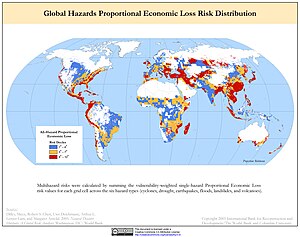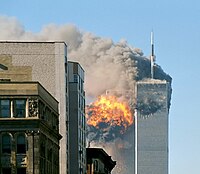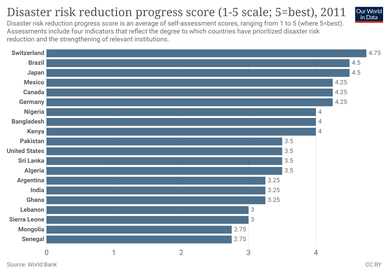A disaster is an event that causes serious harm to people, buildings, economies, or the environment, and the affected community cannot handle it alone.[1][2] Natural disasters like avalanches, floods, earthquakes, and wildfires are caused by natural hazards.[3] Human-made disasters like oil spills, terrorist attacks and power outages are caused by people. Nowadays, it is hard to separate natural and human-made disasters because human actions can make natural disasters worse.[4][5][6]

Disasters usually hit people in developing countries harder than people in wealthy countries. Over 95% of deaths from disasters happen in low-income countries, and those countries lose a lot more money compared to richer countries. For example, the damage from natural disasters is 20 times greater in developing countries than in industrialized countries.[7][8] This is because low-income countries often do not have well-built buildings or good plans to handle emergencies.
To reduce the damage from disasters, it is important to be prepared and have fit for purpose infrastructure. Disaster risk reduction (DRR) aims to make communities stronger and better prepared to handle disasters. When a disaster happens, the response includes actions like warning and evacuating people, rescuing those in danger, and quickly providing food, shelter, and medical care. The goal is to save lives and help people recover as quickly as possible.
Definition and types

The UN defines a disaster as "a serious disruption of the functioning of a community or a society at any scale".[9]: 13 It results from hazards in places where people live in exposed or vulnerable conditions. Some human failures make communities vulnerable to climate hazards. These are poor planning or development, or a lack of preparation.[10]
Disasters are events that have an effect on people. A hazard that overwhelms or injures a community is considered a disaster.[11] The international disaster database EM-DAT defines a disaster as “a situation or event that overwhelms local capacity, necessitating a request for external assistance at the national or international level; it is an unforeseen and often sudden event that causes great damage, destruction and human suffering.”[12] The effects of a disaster include all human, material, economic and environmental losses and impacts.[9]: 13
The scale of a disaster matters. Small-scale disasters only affect local communities but need help beyond the affected community. Large-scale disasters affect wider society and need national or international help.[9]
It is usual to divide disasters into natural or human-made. Recently the divide between natural, man-made and man-accelerated disasters has become harder to draw.[13][14][15] Some manufactured disasters such as smog and acid rain have been wrongly attributed to nature.[16]
Complex disasters, where there is no single root cause, are more common in developing countries. A specific hazard may also spawn a secondary disaster that increases the impact. A classic example is an earthquake that causes a tsunami. This results in coastal flooding, damaging a nuclear power plant on the coast. The Fukushima nuclear disaster is a case in point. Experts examine these cascading events to see how risks and impacts can amplify and spread. This is particularly important given the increase in climate risks.[17]: 143–145
Some researchers distinguish between recurring events like seasonal flooding and unpredictable one-off events.[18] Recurring events often carry an estimate of how often they occur. Experts call this the return period.
Related to natural hazards
Disasters with links to natural hazards are commonly called natural disasters. However experts have questioned this term for a long time.[19]
| Example | Profile |
|---|---|
| Avalanche | The sudden, drastic flow of snow down a slope, occurring when either natural triggers, such as loading from new snow or rain, or artificial triggers, such as explosives or backcountry skiers. |
| Blizzard | A severe snowstorm characterized by very strong winds and low temperatures |
| Earthquake | The shaking of the Earth's crust, caused by underground volcanic forces of breaking and shifting rock beneath the Earth's surface |
| Fire (wild) | Fires that originate in uninhabited areas and which pose the risk to spread to inhabited areas (see also Wildfire § Climate change effects) |
| Flood | Flash flooding: Small creeks, gullies, dry streambeds, ravines, culverts or even low-lying areas flood quickly (see also Effects of climate change) |
| Freezing rain | Rain occurring when outside surface temperature is below freezing |
| Heat wave | A prolonged period of excessively hot weather relative to the usual weather pattern of an area and relative to normal temperatures for the season (see also Effects of climate change § Heat waves and temperature extremes). |
| Landslide | Geological phenomenon which includes a range of ground movement, such as rock falls, deep failure of slopes and shallow debris flows |
| Lightning strike | An electrical discharge caused by lightning, typically during thunderstorms |
| Limnic eruption | The sudden eruption of carbon dioxide from deep lake water |
| Tropical cyclone | Rapidly rotating storm system characterized by a low-pressure center, a closed low-level atmospheric circulation, strong winds, and a spiral arrangement of thunderstorms that produce heavy rain and squalls (see also Tropical cyclones and climate change) |
| Tsunami | A series of waves hitting shores strongly, mainly caused by the displacement of a large volume of a body of water, typically an ocean or a large lake, usually caused by earthquakes, volcanic eruptions, underwater explosions, landslides, glacier calvings, meteorite impacts and other disturbances above or below water |
| Volcanic eruption | The release of hot magma, volcanic ash and/or gases from a volcano |

A natural disaster is the very harmful impact on a society or community after a natural hazard event. Examples of natural hazard events are avalanches, blizzards, droughts, dust storms, earthquakes, floods, hails, heat waves, impact events, landslides, sinkholes, tornadoes, tropical cyclones, tsunamis, volcanic activity and wildfires.[20] A natural disaster can cause loss of life or damage property. It typically causes economic damage. How bad the damage is depends on how well people are prepared for disasters and how strong the buildings, roads, and other structures are.[21] Scholars have been saying that the term natural disaster is unsuitable and should be abandoned.[22] Instead, the simpler term disaster could be used. At the same time the type of hazard would be specificed.[23][24][25] A disaster happens when a natural or human-made hazard impacts a vulnerable community. It results from the combination of the hazard and the exposure of a vulnerable society.
Nowadays it is hard to distinguish between natural and human-made disasters.[22][26][27] The term natural disaster was already challenged in 1976.[25] Human choices in architecture,[28] fire risk,[29][30] and resource management[31] can cause or worsen natural disasters. Climate change also affects how often disasters due to extreme weather hazards happen. These "climate hazards" are floods, heat waves, wildfires, tropical cyclones, and the like.[32]
Some things can make natural disasters worse. Examples are inadequate building norms, marginalization of people and poor choices on land use planning.[22] Many developing countries do not have proper disaster risk reduction systems.[33] This makes them more vulnerable to natural disasters than high income countries. An adverse event only becomes a disaster if it occurs in an area with a vulnerable population.[34][35]Unrelated to natural hazards

Human-made disasters are serious harmful events caused by human actions and social processes. Technological hazards also fall into this category. That is because they result in human-instigated disasters. Human-made hazards are sometimes called anthropogenic hazards.[9]: 18 Examples include criminality, social unrest, crowd crushes, fires, transport accidents, industrial accidents, power outages, oil spills, terrorist attacks, and nuclear explosions/nuclear radiation.[36] Catastrophic climate change, nuclear war, and bioterrorism also fall into this category.
Climate change and environmental degradation are sometimes called socio-natural hazards. These are hazards involving a combination of both natural and human factors.[9] : 18 All disasters can be regarded as human-made, because of failure to introduce the right emergency management measures.[37]
Famines may be caused locally by drought, flood, fire or pestilence. In modern times there is plenty of food globally. Long-lasting local shortages are generally due to government mismanagement, violent conflict, or an economic system that does not distribute food where needed.[38]
| Disaster | Profile |
| Bioterrorism | The intentional release or dissemination of biological agents as a means of coercion |
| Civil unrest | A disturbance caused by a group of people that may include sit-ins and other forms of obstructions, riots, sabotage and other forms of crime, and which is intended to be a demonstration to the public and the government, but can escalate into general chaos |
| Fire (urban) | Even with strict building fire codes, people still perish in fires |
| Hazardous material spills | The escape of solids, liquids, or gases that can harm people, other living organisms, property or the environment, from their intended controlled environment such as a container. |
| Nuclear and radiation accidents | An event involving the significant release of radioactivity to the environment or a reactor core meltdown and which leads to major undesirable consequences to people, the environment, or the facility |
| Power failure | Caused by summer or winter storms, lightning or construction equipment digging in the wrong location |
Major disasters
A study by Sheehan and Hewitt in 1969[39] defined major disasters as conforming to the following criteria, based on the amount of deaths or damage:[40]
- At least 100 people dead,
- at least 100 people injured, or
- at least $1 million damage
This definition includes indirect losses of life caused after the initial onset of the disaster. These could be the effects of diseases such as cholera or dysentery arising from the disaster. This definition is still commonly used. However it is limited to the number of deaths, injuries, and damage in money terms.[40] UNDRO (1984)[citation needed] defined a disaster in a more qualitative fashion as:
an event, concentrated in time and space, in which a community undergoes severe danger and incurs such losses to its members and physical appurtenances that the social structure is disrupted and the fulfilment of all or some of the essential functions of the society is prevented.[41]
Like other definitions this looks beyond the social aspects of the disaster impacts. It also focuses on losses. This raises the need for emergency response as an aspect of the disaster.[40] It does not set out quantitative thresholds or scales for damage, death, or injury.[citation needed]
Impacts
The effects of a disaster include all human, material, economic and environmental losses and impacts.[9]: 13
The Emergency Events Database (EM-DAT) records statistics about disasters related to natural hazards. For 2023, EM-DAT recorded 399 disasters, which was higher than the 20-year average of 369.[12]
Economic losses
Between 2016 and 2020 the total reported economic losses amounted to $293 billion. This figure is likely to be an underestimation. It is very challenging to measure the costs of disasters accurately, and many countries lack the resources and technical capacity to do so.[42]: 50 Over the 40 year period from 1980-2020 losses were estimated at $5.2 trillion.
Human impacts
In 2023, natural hazard-related disasters resulted in 86,473 fatalities and affected 93.1 million people.[12] Whilst the number of deaths was much higher than the 20-year average of 64,148, the number affected was much lower than the 20-year average of 175.5 million.
According to a UN report, 91% of deaths from hazards from 1970 to 2019 occurred in developing countries.[43] These countries already have higher vulnerability and lower resilience to these events, which exacerbates the effects of the hazards.
Effects of climate change
Hazards such as droughts, floods, and cyclones are naturally occurring phenomena.[44] However, climate change has caused these hazards to become more unreliable, frequent and severe. They thus contribute to disaster risks. Countries contributing most to climate change are often at the lowest risk of feeling the consequences.[45] As of 2019, countries with the highest vulnerability per capita release the lowest amount of emissions per capita, and yet still experience the most heightened droughts and extreme precipitation.[45]
Prevention and response
Disaster risk reduction

Disaster response

Disaster response is the actions taken directly before, during or immediately after a disaster. The objective is to save lives, ensure health and safety and to meet the subsistence needs of the people affected.[49]: 16 It includes warning and evacuation, search and rescue, providing immediate assistance, assessing damage, continuing assistance and the immediate restoration or construction of infrastructure. An example of this would be building provisional storm drains or diversion dams. Emergency response aims to provide immediate help to keep people alive, improve their health and support their morale. It can involve specific but limited aid, such as helping refugees with transport, temporary shelter, and food. Or it can involve establishing semi-permanent settlements in camps and other locations. It may also involve initial repairs to damage to infrastructure, or diverting it.
The response phase focuses on keeping people safe, preventing the next disasters and meeting people's basic needs until more permanent and sustainable solutions are available. The governments where the disaster has happened have the main responsibility for addressing these needs. Humanitarian organisations are often present in this phase of the disaster management cycle. This is particularly so in countries where the government does not have the resources for a full response.Etymology
The word disaster is derived from Middle French désastre which comes from Old Italian disastro. This in turn comes from the Ancient Greek pejorative prefix δυσ- (dus-) "bad"[50] and ἀστήρ (aster), "star".[51] So the word disaster ("bad star" in Greek) comes from an astrological sense of a calamity blamed on the position of planets.[52]
See also
References
External links

- International Federation of Red Cross and Red Crescent Societies – IFRC
- ReliefWeb of the United Nations Office for the Coordination of Humanitarian Affairs –ReliefWeb
- United Nations Office for Disaster Risk Reduction – UNDRR
- EM-DAT International Disaster Database of the Centre for Research on the Epidemiology of Disasters
- Global Disaster Alert and Coordination System – a joint initiative of the United Nations Office for the Coordination of Humanitarian Affairs (OCHA) and the European Commission
- UN-SPIDER – UN-SPIDER, the United Nations Platform for Space-based Information for Disaster Management and Emergency Response], a project of the United Nations Office for Outer Space Affairs (UNOOSA)






